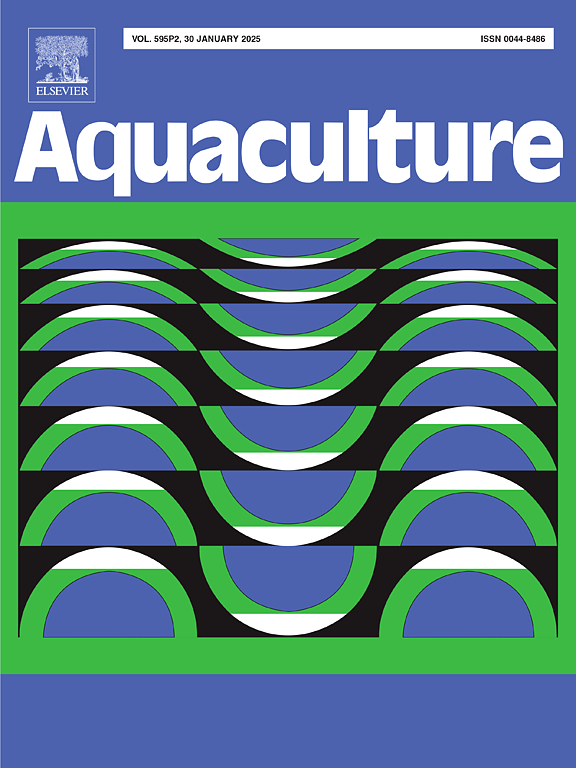Temperature impact on replication and virulence of European infectious hematopoietic necrosis viruses
IF 3.9
1区 农林科学
Q1 FISHERIES
引用次数: 0
Abstract
Sporadic acute IHN outbreaks at water temperatures above 14 °C have been reported, challenging the temperature upper limit for IHN epizootics. The influence of temperature on European Infectious Hematopoietic Necrosis Virus (IHNV) was tested in vitro on five selected isolates of IHNV. Each isolate was tested by end-point titration onto EPC monolayers incubated at 15 °C, 20 °C, 22 °C and 25 °C. Replication was hindered at 22 °C for IHNV isolates IT-217A (IHNV 217/A), IHNV/O.mykiss/I/TN/224–2/Mar18 (IHNV 224–2), IHNV/O.mykiss/I/TN/534/Dec11 (IHNV 534), whereas isolates IHNV DK-FF1/21–4070–1 (IHNV DK) and IHNV/O.mykiss/I/BG/67–1/Feb22 (IHNV 67–1) were not affected. Further increase of incubation temperature to 25 °C significantly limited replication for all the isolates. IHNV 67–1, IHN 224–2 and IHNV DK were selected for the in vivo trial. Rainbow trout juveniles were exposed to IHNV and housed at water temperatures of 12 °C and 19 °C for 28 days. IHNV 67–1 induced clinical disease with reduced survival both at 12 °C and 19 °C. Isolate IHNV 224–2, which showed limited replication at 22 °C in vitro, reduced survival only at 12 °C. Isolate IHNV DK, capable of replication at 22 °C in vitro, severely reduced survival only at 12 °C. Isolates IHNV DK and IHNV 67–1 showed an insertion of seven amino acids in the 3′ end part of the coding region of the L gene. This mutation can potentially play a role in their adaptation at warm temperature. Characterization of further IHNV isolates, analysis of other genes and evaluation of the host immune response at different temperatures are necessary to investigate the temperature influence on IHNV virulence.
温度对欧洲传染性造血坏死病毒复制和毒力的影响
已报告在水温高于14°C的水域暴发了零星急性IHN疫情,挑战了IHN动物流行病的温度上限。用5株欧洲传染性造血坏死病毒(IHNV)分离株,在体外试验了温度对IHNV的影响。每个分离物在15°C、20°C、22°C和25°C孵育的EPC单层膜上通过终点滴定进行检测。IHNV分离株IT-217A (IHNV 217/A)、IHNV/O在22°C时复制受阻。mykiss/I/TN/ 224-2 /Mar18 (IHNV 224-2), IHNV/O。mykiss/I/TN/534/Dec11 (IHNV 534), IHNV DK- ff1 /21 - 4070 - 1 (IHNV DK)和IHNV/O。mykiss/I/BG/ 67-1 /Feb22 (IHNV 67-1)未受影响。进一步提高培养温度至25°C显著限制了所有分离株的复制。选择IHNV 67-1、IHNV 224-2和IHNV DK进行体内试验。虹鳟鱼幼鱼暴露于IHNV,并在12°C和19°C的水温下饲养28天。在12°C和19°C条件下,IHNV 67-1诱导临床疾病,生存率降低。分离的IHNV 224-2在体外22°C时复制有限,仅在12°C时降低存活。分离的IHNV DK能够在体外22°C下复制,仅在12°C下严重降低存活率。分离株IHNV DK和IHNV 67-1在L基因编码区3 '端插入了7个氨基酸。这种突变可能在它们适应温暖温度的过程中发挥作用。为了研究温度对IHNV毒力的影响,进一步鉴定IHNV分离株、分析其他基因和评估不同温度下宿主免疫反应是必要的。
本文章由计算机程序翻译,如有差异,请以英文原文为准。
求助全文
约1分钟内获得全文
求助全文
来源期刊

Aquaculture
农林科学-海洋与淡水生物学
CiteScore
8.60
自引率
17.80%
发文量
1246
审稿时长
56 days
期刊介绍:
Aquaculture is an international journal for the exploration, improvement and management of all freshwater and marine food resources. It publishes novel and innovative research of world-wide interest on farming of aquatic organisms, which includes finfish, mollusks, crustaceans and aquatic plants for human consumption. Research on ornamentals is not a focus of the Journal. Aquaculture only publishes papers with a clear relevance to improving aquaculture practices or a potential application.
 求助内容:
求助内容: 应助结果提醒方式:
应助结果提醒方式:


